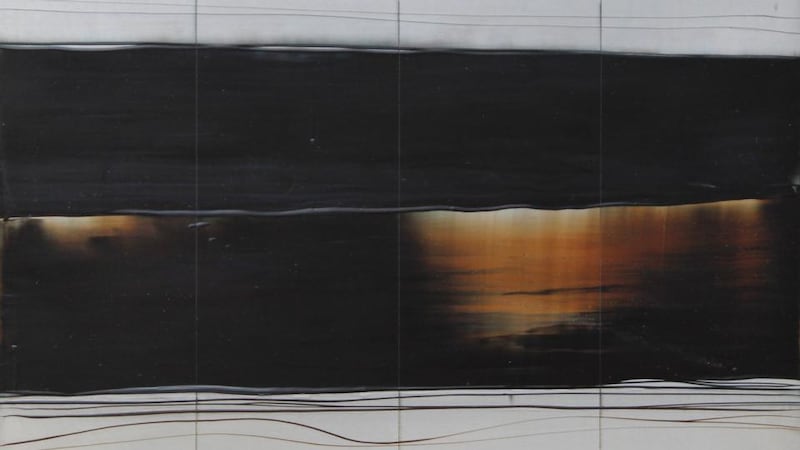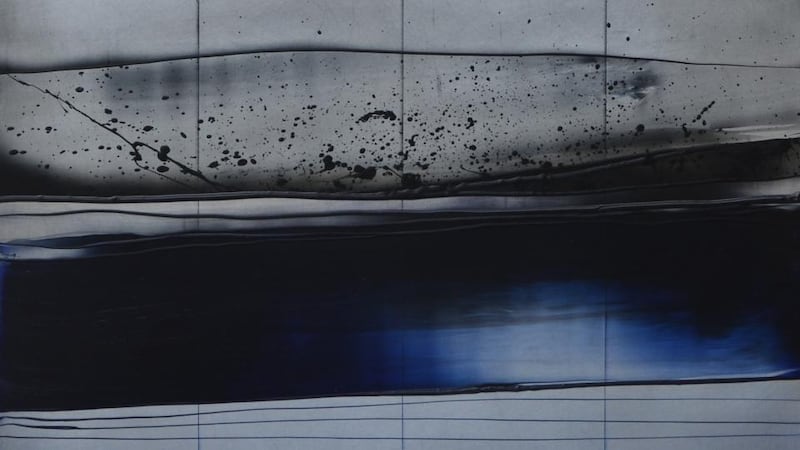Charles Tyrrell
Recent paintings and drawings
Uillinn, West Cork Arts Centre, Skibbereen


****
The galleries in Uillinn, the new West Cork Arts Centre in Skibbereen, have quickly acquired a reputation for being accommodating and spacious but very tricky. Neither the main James O’Driscoll Gallery nor Gallery II offers a simple, quiet, symmetrical room. As spaces, both are distinctly asymmetrical and unsettling, and in architectural terms both are busy, even when vacant. When he was invited to have a solo show there, Charles Tyrrell took a practical approach to dealing with this. Not only did he build his exhibition around the given structures, but several pieces were made with the dimensions and character of the galleries in mind.
Tyrrell is based close to Allihies on the Beara Peninsula, perched on a rocky promontory at the edge of the Atlantic. He has a stocky, broad physique and a patient, quizzical demeanour that seem ideally suited to the uncompromising setting. Now in his 60s, he is one of the pre-eminent Irish artists of his generation, although he has always measured his work in international terms.
His show comprises a series of near-monochromatic paintings on aluminium, and a series of drawings. The latter group is from an ongoing project whereby he makes a drawing every day, all rendered in a precise, spidery line. Why are the paintings on aluminium? He makes paintings by means of a cumulative process of addition and subtraction, building up, erasing and rebuilding. Some time ago he realised that working on aluminium offered a useful variation on this process.
His compositions hinge on an underlying grid structure, implicit but not necessarily apparent. The grid could be scored into the metal surface so that it’s always there without being physically reinforced. And layers of paint can be scraped back to virtually nothing so that, no matter how many layers of making and unmaking have gone into an eventual image, the freshness of the final version is all that survives.
The industrious student
Going back to the beginning, he attended NCAD at a moment of historical change, fuelled by student and some staff protest, in the first half of the 1970s. Michael Cullen and Martin Gale were among his contemporaries. Like them, he looked well beyond the borders of the conservative institution and the Irish art scene. In his case, that meant European and American abstract painting. During his final two years in college, he seemed to work independently of his nominal teachers. Far from conforming to the caricature of the work-shy bohemian student protester, however, he was exceptionally disciplined and industrious. Even as a student, he was clearly committed to painting as a serious, full-time occupation.
Following his graduation, thoroughly at home in the idiom of large-scale abstraction, he held a remarkably assured solo show at Project Arts Centre. He was born in Trim, Co Meath, but after NCAD he continued to live in Dublin for a further 10 years, for most of that time sharing a huge, crumbling Georgian house on Mountjoy Square. Although it was primitive in some regards, it meant he could live quite cheaply while having generous studio space. He also, incidentally, incorporated massive beams from nearby demolished buildings in one memorable series of works. Over those 10 years he developed his own distinctive artistic personality.
Writing in The Irish Times, Des McAvock accurately summed that personality up as a combination of "austerity and lyricism". His paintings were to all intents and purposes abstract. Composed in terms of an underlying grid, they were further based on geometric subdivisions. But increasingly there was an atmospheric subtlety in their layers of colour and tone. And other, non-geometric marks began to appear.
The move to Beara
This tendency was enhanced following his move to Beara in 1984. He had visited the area several times but it was still a surprising move for a young artist. Logic suggested that if he was not based in Dublin, he should perhaps head to London or New York. Yet there is a kind of sense to it when you view Tyrrell in the context of such artists as Bridget Riley, Agnes Martin, Giorgio Morandi or Mark Rothko, as you logically should. There is a monastic rigour to their practice, and that suggests an indifference to immediate surroundings or, in some cases, a conscious rejection of distraction. Looking at Tyrrell's daily studio routine – he feels uneasy if he misses out on the hours in the studio even for a couple of days – it would not have been surprising if he had gone the whole hog and moved to the Skelligs.
Yet in the clear, uncluttered environment of Beara, itself close to abstraction, nature found a perceptible place in his work. “I am wary of relying on suggestions from the landscape,” he said in an interview. But equally, he recognised that his painting was inescapably a distillation of his own experience. The landscape was an inextricable part of that experience. He elaborated: “I’m not abstracting from the real but coming at it the other way round.” Beginning with the logic of the grid, with geometry, he would “build to the human reality of confusion and fallibility”.
Here, the thoughts of the German painter Gerhard Richter are entirely appropriate to Tyrrell when he says of his abstract paintings that is he not aiming for an imitation of nature, which inevitably seems false, but for "rightness": "In nature everything is always right . . . My work has so much to do with reality that I want it to have a corresponding rightness." Tyrrell always aims for, and only accepts, that rightness.








